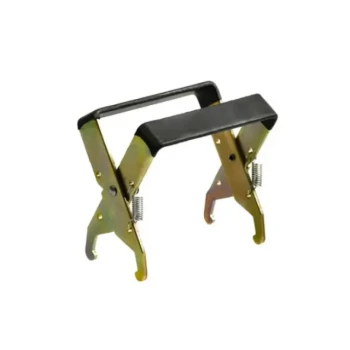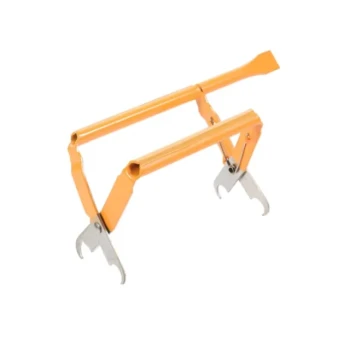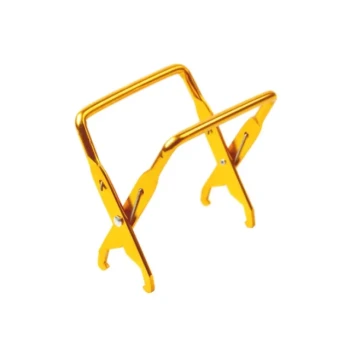At its core, the choice of beehive frames and foundation comes down to a decision between wood and plastic components. This choice dictates not only your initial setup cost and effort but also your long-term maintenance workload and beekeeping philosophy. You can opt for traditional wooden frames where you install a separate foundation, all-in-one plastic units, or foundationless frames that encourage bees to build comb naturally.
The decision between wood and plastic frames is a classic trade-off between traditional aesthetics and operational efficiency. Your ideal choice is less about which is "best" and more about which best aligns with your goals, be it speed, scalability, or a more natural approach to beekeeping.
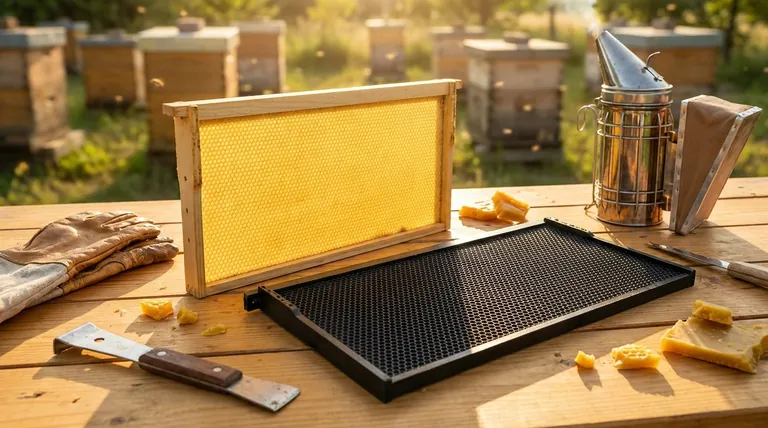
The Core Components: Frame and Foundation
Before comparing systems, it's critical to understand the role each component plays within the hive.
What is a Frame?
A frame is a rectangular structure, typically made of wood or plastic, that hangs inside the hive body. Its purpose is to provide a standardized, removable structure for bees to build their comb on. This allows beekeepers to inspect the colony's health, check for pests, and harvest honey without destroying the comb.
What is Foundation?
Foundation is a thin sheet of beeswax or plastic imprinted with the hexagonal pattern of honeycomb cells. It is placed inside a frame to give the bees a guide, encouraging them to build straight, even comb that is easy to manage and inspect.
Option 1: The Traditional Wooden Frame
Wooden frames are the classic choice, offering flexibility but often requiring more hands-on preparation and maintenance.
Wood Frames with Insertable Foundation
This is the most traditional method. You purchase wooden frame components (top bar, bottom bar, two side bars) and assemble them. You then install a separate sheet of foundation—either pure beeswax or plastic—into the frame.
This approach gives you granular control over the materials inside your hive.
The Foundationless Method
For beekeepers who prefer a more natural approach, foundationless frames are an option. This involves using a standard wooden frame with only a "starter strip" of wood or wax along the top bar.
This encourages bees to build their own comb from scratch, determining their own cell size. While many purists prefer this, it requires more monitoring to prevent bees from building disorganized, cross-connected comb that is difficult to inspect.
Option 2: The All-in-One Plastic Frame
Modern beekeeping has embraced integrated plastic frames for their durability and efficiency.
Integrated Plastic Frame and Foundation
These are single-piece molded plastic units that combine the frame and foundation into one component. They are ready to be placed directly into the hive with no assembly required.
Their primary advantage is speed and durability. They are less prone to breaking during inspections or honey extraction and can be cleaned more aggressively than wood.
Best Practices for Plastic
Bee acceptance is highest on heavily waxed plastic frames. Many manufacturers apply wax, but experienced beekeepers often add an extra coat of melted beeswax to encourage bees to start building comb faster.
A common professional strategy is to use black plastic foundation in the brood boxes (where the queen lays eggs), as the dark color makes it easier to spot white eggs and young larvae. Yellow or white foundation is often used in honey supers.
Understanding the Trade-offs: Wood vs. Plastic
Your decision should be based on a clear understanding of the trade-offs between cost, durability, and ease of use.
Cost and Durability
Wooden frames are often cheaper per unit initially but are more fragile and susceptible to damage from hive tools and pests. They require more frequent repair and replacement.
Plastic frames have a higher upfront cost but are a superior long-term investment, especially for beekeepers with many hives. Their durability dramatically reduces replacement and maintenance costs over time.
Ease of Use and Speed
Plastic frames are the clear winner for speed and ease. They are ready for immediate use out of the box, saving significant time on assembly.
Wooden frames require assembly and foundation installation, which can be time-consuming and tedious, especially for those managing multiple hives.
Bee Acceptance
Bees will readily build on any surface, but they are fastest to draw out comb on pure beeswax. Well-waxed plastic is, however, accepted very quickly by most colonies. Foundationless wood frames rely entirely on the bees' instinct to build.
Making the Right Choice for Your Goal
Select your frame system based on your primary objective as a beekeeper.
- If your primary focus is a natural, low-intervention approach: Choose foundationless wooden frames to allow bees to build their own comb, but be prepared for a steeper learning curve.
- If your primary focus is getting started quickly with minimal hassle: Use all-in-one plastic frames or pre-assembled wooden frames with foundation already installed.
- If your primary focus is scaling your operation for efficiency and longevity: Standardize on heavily waxed, one-piece plastic frames to minimize labor and replacement costs.
Ultimately, the best frame system is the one that aligns with your management style and empowers you to confidently care for your bees.
Summary Table:
| Feature | Wooden Frames | Plastic Frames |
|---|---|---|
| Initial Cost | Lower | Higher |
| Long-Term Durability | Lower (requires repair) | Higher (long-lasting) |
| Ease of Use | Requires assembly | Ready-to-use |
| Best For | Natural/artisanal approach | Efficiency & scaling operations |
Ready to optimize your apiary's efficiency and durability? As a trusted wholesale supplier to commercial apiaries and distributors, HONESTBEE provides high-quality, heavily waxed plastic frames and other essential beekeeping supplies designed for scale and longevity. Let our expertise help you reduce long-term costs and streamline your operations.
Contact HONESTBEE today for wholesale pricing and to discuss your specific needs!
Visual Guide
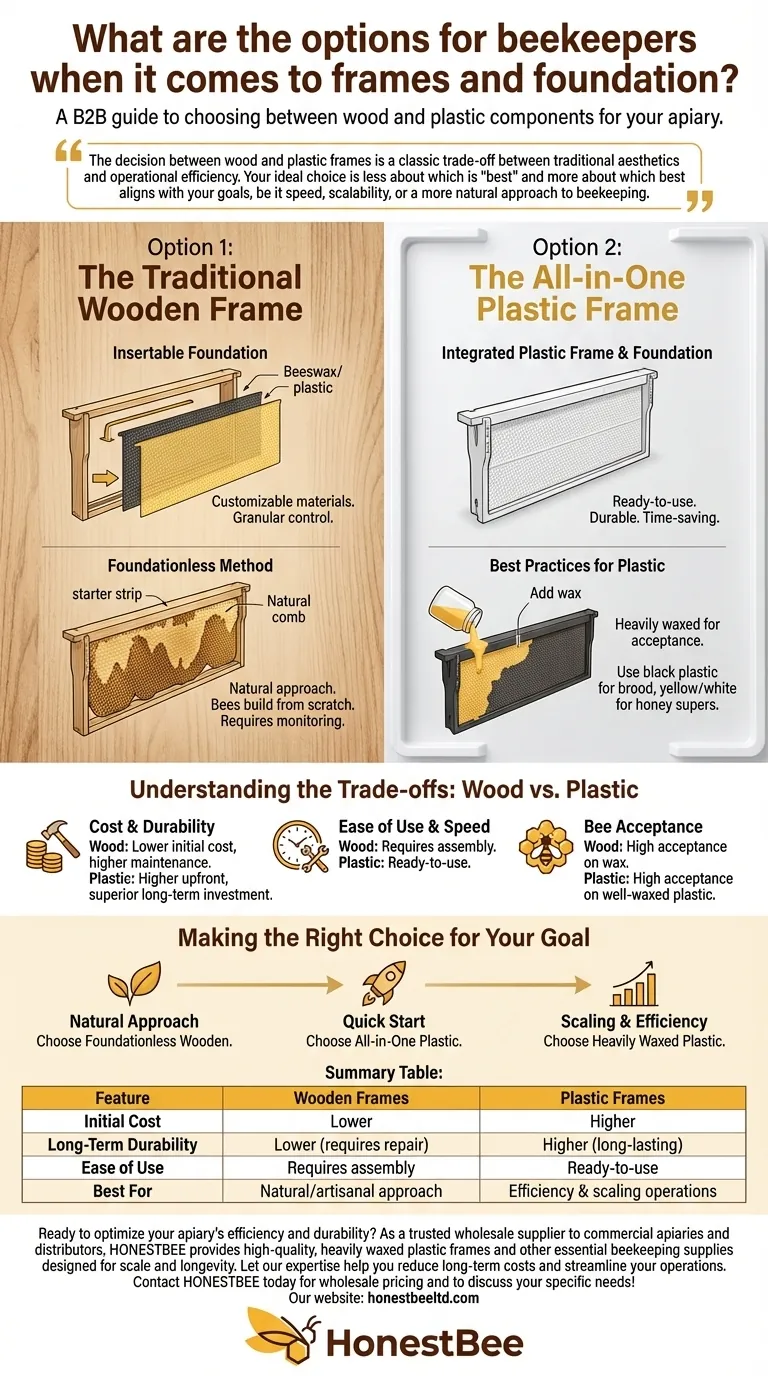
Related Products
- Food Grade Plastic bee Foundation for Bee Frames
- Durable Rubberized Comfort Handle Frame Grip
- Durable Galvanized Steel Frame Grip
- HONESTBEE Professional Long Handled Hive Tool with Precision Cutting Blade
- Professional Galvanized Hive Strap with Secure Locking Buckle for Beekeeping
People Also Ask
- How to get bees to use plastic foundation? Master the Wax Coating and Resource Strategy
- What is a plastic foundation sheet? A Durable, Reusable Hive Management Solution
- What additional step can improve the performance of plastic foundation in the hive? Apply a Generous Coat of Beeswax
- What factors should beekeepers consider when choosing between beeswax and plastic foundation? A Guide to Durability vs. Natural Philosophy
- Why do commercial beekeepers prefer plastic foundation? Durable, Reusable, and Cost-Effective

